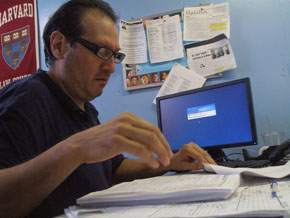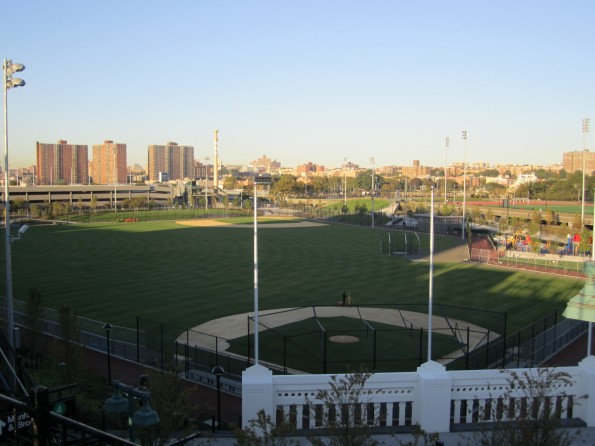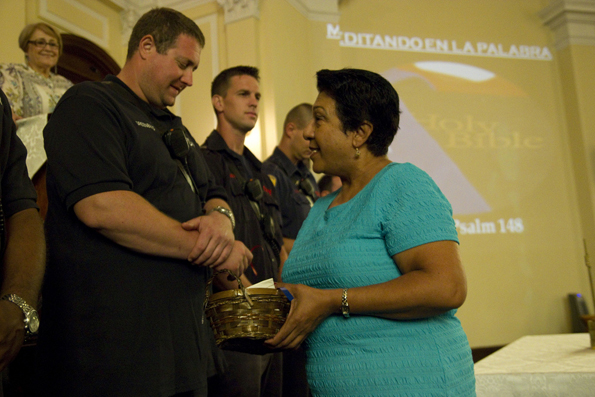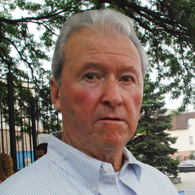
Juan Ramon Rios works to combat smoking and promote health eating in Highbridge (NIGEL CHIWAYA/The Bronx Ink)
Hints into Juan Ramon Rios’s past and present are abundant.
The way Rios rolls the r’s in “Ramon Rios” speaks to his Puerto Rican heritage. The Yankees hat on his back shelf reveals a native allegiance to baseball. Photos of himself and students meeting with Sen. Ruben Diaz, Sr. hint at the appeal of political activism.
But it is the Harvard Law School banner that is the most curious. It’s the only reminder of his former life.
Rios, 45, was previously a litigation lawyer, a career that involved suits, ties and California sun. It was a life that thousands of law students dream of every year. But it kept the Mott Haven native away from the Bronx, and so it didn’t make Rios happy.
“My dream was to come back to the community and help,” said the dark-haired, bespectacled Rios. “But the work I was doing was interfering with that.”
Rios, who traveled the world to become a lawyer and escape the poverty of the South Bronx, found that the South Bronx was where he wanted to be all along. So Rios traded in the suit, tie and high salary to return to the Bronx improve the health of the children of the South Bronx.
Rios runs the center’s Healthy Highbridge program where he, among other things, has championed the city’s recent smoking ban in parks and beaches. Rios also created a health curriculum for the students of P.S. 73.
Rios stresses healthy habits to Bronx kids because he’s seen the effects of the bad ones. The son of two Puerto Rican immigrants, Rios grew up in the Mitchel housing project in Mott Haven and came of age during the Bronx’s low period in the 1970s, when crime, drugs and arson committed by landlords crippled the borough.
“A lot of my friends from that era,” said Rios, “are either dead, in prison, or they fell into substance abuse.”
Rios avoided falling into those same habits in part because of his parent’s work ethic. Neither of them spoke English fluently, but his mother taught herself while his father labored as a factory worker.
According to Rios, this dedication to hard work translated to their children. Rios’ older sister, Angela, graduated from Columbia University with an engineering degree.
Rios took a different route. He joined the military after high school, touring the world as an emergency medical technician in the Navy. Though he was stationed in California, Rios’ tour took him through Europe, Asia and Australia.
After four years in the Navy, Rios returned to New York and worked on Wall Street at Smith Barney, starting as a clerk and working his way up to the position of assistant broker despite never having gone to college.
The lack of a higher education degree caught up with Rios a few years later, when Rios said he “saw the ceiling” in finance. So Rios enrolled at John Jay College of Criminal Justice, where he studied government and philosophy and graduated with a 3.98 GPA – good enough to get him into Harvard Law School.
Timothy Stroup, a philosophy professor at John Jay, recalled Rios’s time at the college. Stroup, who taught Rios in an ethics and law class, noted that Rios “was always the first to volunteer” in class.
“He just has an unquenchable love of learning,” said Stroup, 68.
Stroup noted a mock affirmative action debate he held during the final class of the semester. The students were to argue against their natural belief. Rios was one of the three debate captains. Stroup was so impressed with the performance that he struck up a friendship with Rios and the two other captains, who went on to attend Boston College law school. With all three students in the Boston area, Stroup and his wife, Alice, would visit the students and take them out to dinner once a semester. Though the tradition has lagged in the past year, Stroup, who has been a professor for over 40 years, still speaks highly of Rios.
“He’s one of the students of which I’m most proud,” Stroup said.
After law school Rios went west, where he worked for the law firm Jones Day in California for two years. He followed this up with a two-year stint at Gary Wright in New York.
According to Rios, life as a lawyer was tough. Rios said he waded through piles of documents and law books, researching complex trade laws and advising big clients.
The job came with a big paycheck, which Rios, who originally wanted to become a criminal prosecutor, needed to pay off the Harvard student loans, but it also came with a culture shock. The poor Puerto Rican kid from the Bronx was now a big-time lawyer, hanging out with other rich lawyers and seeing the disparity between where they lived and where his family still lives. Rios said that this “dark contrast” began to gnaw at him.
“It was really an eye-opener,” Rios said, “to see that certain classes have more than others. It instills an understanding that you have to come back.”
Stroup was unsurprised by his former student’s struggle to cope with the world of law, saying, “It’s one thing to play devil’s advocate in class. It’s another thing to have to actually represent real devils in business. Juan found it inconsistent to work for big corporations.”
Rios said he began to wonder what he could do to help those back home in the Bronx. He settled on children, realizing that if he couldn’t work as a prosecutor to keep criminals off the streets, he would try to reach them before they became criminals.
And so, in 2005, Rios changed careers again. This time he left law behind to become a New York City teaching fellow. Rios returned to the Bronx and was placed in Christopher Columbus High School in the Pelham Parkway section of the Bronx, where he taught social studies to grades 9 and 12.
Rios, who now owns a house in Morrisania, said that he earned more satisfaction from his five years at Columbus than during his time as a lawyer. Rios is especially proud of his work with Columbus’ high school seniors, for whom Rios said he wrote “dozens” of college recommendations.
After his teaching licensed expired last year, Rios didn’t get it renewed. He decided to give one last shot at law, trying to run his own private practice. However, Rios said that “difficulties” led him to dissolve the partnership. Once again, Rios could go in any direction. Unsurprisingly, he decided to help the community.
Rios said he heard through friends that the Highbridge Community Life Center was looking for a program assistant that would help promote health in the neighborhood. With nothing to lose, the former medic decided to give it a shot.
One year later, Rios has already drafted the health and wellness curriculum for P.S. 73. The program, which features bilingual lessons on healthy eating, the dangers of smoking and the merits of exercise, debuted for fifth graders last year and was expanded to include fourth grades this year. Rios teaches the courses himself, fittingly placing him back in the classroom.
In addition, Rios has championed the smoke-free New York campaign, lobbying in Albany for a ban on smoking in parks, plazas and beaches. The law was successfully passed in February.
Outside of the Highbridge center, Rios is still active in the area. He sits on the community board four health committee and said he never misses a general meeting.
When asked why he works so hard for the children of the Bronx, Rios’ answer hints at a slight selfishness. Though Rios, who is engaged, doesn’t have any children of his own, he said he does have to look out for his former students.
“You could say,” Rios noted, “that I have 8,000 kids.”

















